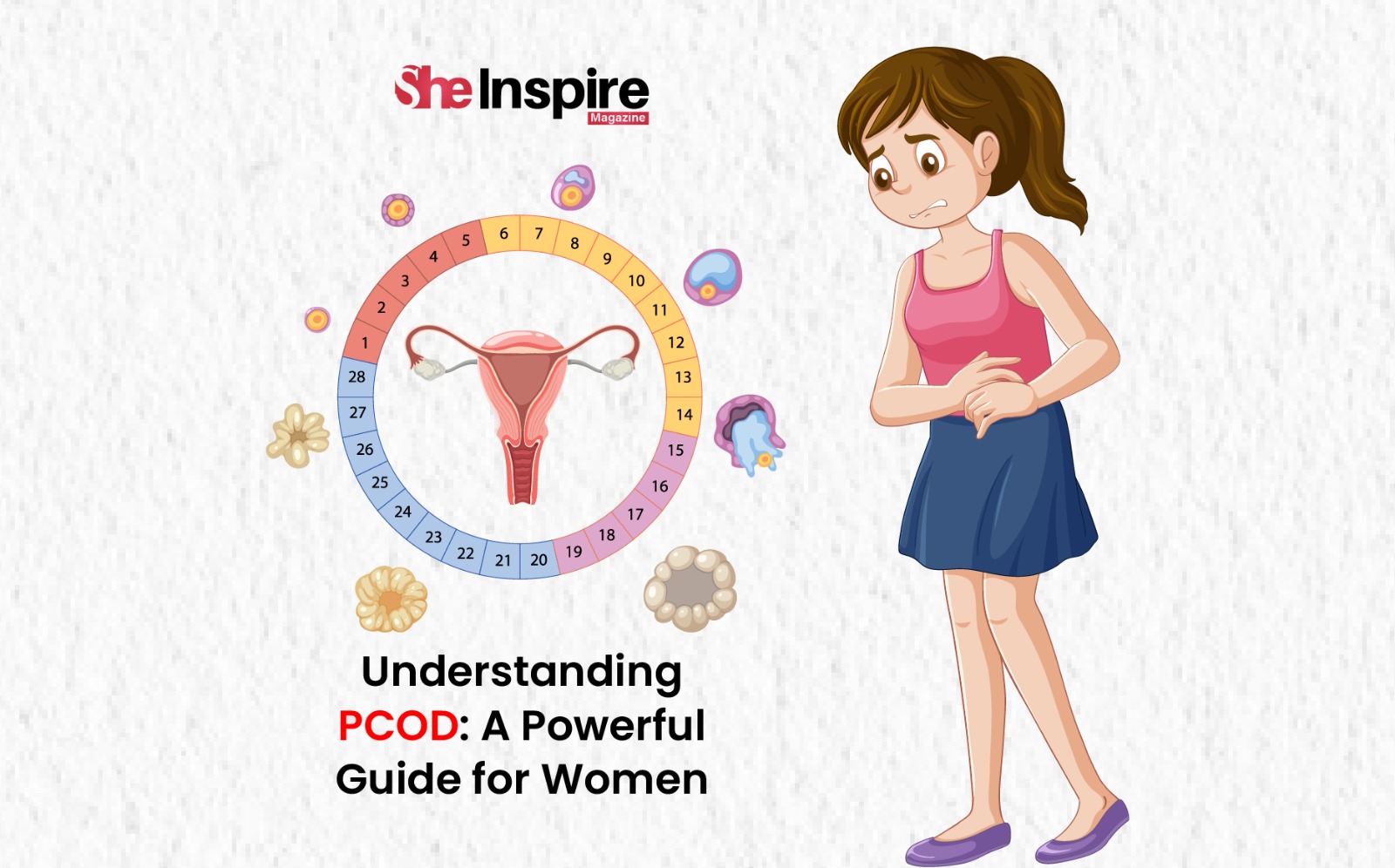Understanding PCOD: A Powerful Guide for Women

When we talk about women’s health, one name that often pops up — but still remains widely misunderstood — is Polycystic Ovarian Disease (PCOD). For the female readers of She?Inspire, this blog is your companion: to demystify PCOD, explore how it shows up in your life, and empower you with tools to take charge.
What is PCOD?
PCOD is a hormonal and ovarian condition where the ovaries produce many immature or partially mature eggs, or in some cases have multiple small cysts. But more than the cysts themselves, the key issue is hormonal imbalance — particularly involving androgens (male-type hormones), insulin resistance, or both. The term PCOD is sometimes used interchangeably with Polycystic Ovary Syndrome (PCOS), but experts may use PCOS to describe a broader metabolic condition.
Why it Matters
PCOD doesn’t just affect your periods. It’s about how your body’s endocrine system interacts with your metabolism, your skin, your hair, your fertility and even your future health. It may quietly increase risks for other conditions like type?2 diabetes, high blood pressure, cardiovascular issues and uterine problems if unaddressed. For many women, the emotional and social impact — from acne to unwanted hair, from weight gain to fertility concerns — can be overwhelming. Awareness is your first step to empowerment.
Recognising the Signs: What to Look For
Every woman’s experience is different — you may see some symptoms but not all. Here are common red flags:
• Irregular menstrual cycles: fewer than 8 periods a year, cycles longer than 35 days, or skipping them altogether.
• Signs of excess androgens: unwanted facial/body hair, acne, oily skin, male-pattern hair thinning on the scalp.
• Difficulty losing weight or unexpected weight gain — particularly around the belly.
• Dark patches of skin (especially in folds like neck, armpits, groin).
• Fertility or ovulation issues: not ovulating regularly or trouble conceiving.
What Causes PCOD?
There’s no single cause, but rather multiple factors that interplay:
• Genetic predisposition: Family history matters.
• Insulin resistance: When your cells are less responsive to insulin, the body compensates by producing more — this can trigger higher androgen production.
• Low-grade inflammation: Studies suggest women with PCOD often have subtle, ongoing inflammation that may worsen hormone imbalance.
• Lifestyle & environment: Poor diet, sedentary habits, and chronic stress can worsen insulin resistance and hormone imbalance.
How is it Diagnosed?
Your healthcare provider may use a combination of:
• Medical history and symptom review.
• Physical exam and ultrasound to look at ovaries and follicles.
• Blood tests to check hormone levels, glucose, and lipid profile.
A key point: just having cysts on the ovaries doesn’t automatically mean PCOD, and many with PCOD may not have typical cysts.
Living with PCOD: What You Can Do
The good news: while PCOD may not have a simple “cure”, you can manage it effectively — and live fully.
1. Lifestyle Changes — The Core Pillar
• Aim for a balanced diet – rich in fibre, lean proteins, whole grains, and vegetables; limit processed and high-sugar foods.
• Exercise regularly – even moderate activity (5 days a week) can help insulin sensitivity and regulate weight.
• Manage stress and sleep – chronic stress and poor sleep can worsen hormone imbalance.
• Small wins matter: losing 5–10% of your body weight can significantly improve symptoms.
2. Medical & Therapeutic Options
Depending on your symptoms and goals, your doctor may suggest:
• Hormonal birth control pills to regulate cycles and reduce androgens.
• Insulin-sensitising medications when insulin resistance is significant.
• Treatments for specific issues like acne, excess hair, and fertility.
3. Focus on Your Fertility & Future Health
If you plan to conceive, engage proactively — track ovulation, consult a fertility specialist if needed, and monitor for long-term health risks like diabetes and heart issues.
Special Considerations for Indian Women
The prevalence of PCOD in India is significant, but many women remain undiagnosed. Cultural expectations and body-image issues may add challenges, so talk openly with your doctor. Traditional Indian diets high in carbohydrates may require careful tailoring when insulin resistance is present. Community support matters — you’re not alone. Reach out to women’s health groups and lean on friends and family.
Empower Yourself: What You Can Do Today
• Keep a period journal to track your cycle and symptoms.
• Set one small lifestyle goal for the week — such as walking daily or reducing sugar intake.
• Ask your doctor key questions about your symptoms and options.
• Join a support group or online community.
• Remember: Your body is not “broken.” PCOD is a condition that many women live with and manage remarkably well.
Final Word
On She?Inspire, we believe knowledge empowers. PCOD is not a myth or mere “bad periods” — but a complex interplay of hormones, metabolism and health. By understanding what’s happening beneath the surface, recognising the signals your body gives you, and intentionally managing lifestyle and medical care, you can reclaim agency. Your cycle, your skin, your fertility, your wellbeing — all of it matters. Don’t wait for a crisis. Start now, talk to your doctor, and inspire others by taking that first step.
Disclaimer: This blog is for informational purposes only and does not replace medical advice. Always consult a qualified healthcare provider for diagnosis and treatment.


